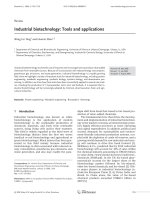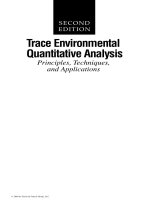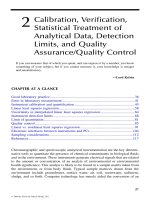Economics principles tools and applications 9th by sullivan sheffrin perez chapter 22
Bạn đang xem bản rút gọn của tài liệu. Xem và tải ngay bản đầy đủ của tài liệu tại đây (797.96 KB, 32 trang )
Economics
NINTH EDITION
Chapter 22
Insert Cover Picture
Consumer Choice:
Utility Theory and
Insights from
Neuroscience
Copyright © 2015, 2012, 2009 Pearson Education, Inc. All Rights Reserved
Learning Objectives
22.1 Explain the equimarginal principle and apply it to consumer choice.
22.2 Describe the income and substitution effects of a price change.
22.3 Describe the general process involved in the valuation of the benefits and costs of a consumer
good.
22.4 Apply the insights from neuroscience to consumer decisions about nutrition and saving.
Copyright © 2015, 2012, 2009 Pearson Education, Inc. All Rights Reserved
22.1 TRADITIONAL CONSUMER CHOICE: UTILITY THEORY (1 of 6)
Consumer Constraints: The Budget Line
A consumer’s budget line shows all the combinations of two goods that exhaust
the budget. The slope of the budget line is the opportunity cost of a movie in
terms of books.
The budget set (the shaded triangle) shows all the affordable combinations of
books and movies, and the budget line (with endpoints r and v) shows the
combinations that exhaust the budget
Copyright © 2015, 2012, 2009 Pearson Education, Inc. All Rights Reserved
22.1 TRADITIONAL CONSUMER CHOICE: UTILITY THEORY (2 of 6)
Total and Marginal Utility
The consumer’s objective is to maximize utility. The upper panel shows the
relationship between total utility and the number of movies watched.
In the lower panel, the marginal utility from movies decreases as the number of
movies increases.
Copyright © 2015, 2012, 2009 Pearson Education, Inc. All Rights Reserved
22.1 TRADITIONAL CONSUMER CHOICE: UTILITY THEORY (3 of 6)
The Marginal Principle and the Equimarginal Rule
MARGINAL PRINCIPLE
Increase the level of an activity as long as its marginal benefit
exceeds its marginal cost. Choose the level at which the marginal
benefit equals the marginal cost.
The marginal utility of movies decreases as the number of movies
increases, reflecting the assumption of diminishing marginal utility. The
marginal utility per dollar equals the marginal utility divided by the price of
movies.
Copyright © 2015, 2012, 2009 Pearson Education, Inc. All Rights Reserved
22.1 TRADITIONAL CONSUMER CHOICE: UTILITY THEORY (4 of 6)
Conditions for Maximizing Utility
MARGINAL PRINCIPLE
Increase the level of an activity as long as its marginal benefit exceeds its
marginal cost. Choose the level at which the marginal benefit equals the
marginal cost.
The consumer picks the affordable bundle at which the marginal utility per
dollar on movies equals the marginal utility per dollar on books. This is shown
by point a (6 movies) and point b (9 books). Starting from any other affordable
combination, the consumer can do better by reallocating the budget in favor of
the good with the larger marginal utility per dollar. For example, starting from
points c and d, movies have a larger marginal utility per dollar, so the
consumer can increase utility by choosing more movies and fewer books.
Copyright © 2015, 2012, 2009 Pearson Education, Inc. All Rights Reserved
22.1 TRADITIONAL CONSUMER CHOICE: UTILITY THEORY (5 of 6)
Making Choices Using the Equimarginal Rule
●
Equimarginal rule
Pick the combination of two activities where the marginal benefit per dollar for
marginal benefit per dollar for the second activity.
Copyright © 2015, 2012, 2009 Pearson Education, Inc. All Rights Reserved
the first activity equals the
22.1 TRADITIONAL CONSUMER CHOICE: UTILITY THEORY (6 of 6)
Making Choices Using the Equimarginal Rule
TABLE 22.1 Utility Maximization
Marginal
Marginal
Marginal
Marginal
Utility
Utility
Utility:
Utility:
Utility per $:
Utility per $:
from
from
Total
Movies
Books
Movies
Books
Movies
Books
Movies
Books
Utility
1
24
51
2
17
2
51
216
267
2
21
48
4
16
4
99
210
309
3
18
45
6
15
6
144
198
342
4
15
42
8
14
8
186
180
366
5
12
39
10
13
10
225
156
381
6
9
36
12
12
12
261
126
387
7
6
33
14
11
14
294
90
384
8
3
30
16
10
16
324
48
372
EQUIMARGINAL RULE
Pick the where the marginal benefit per dollar for the first activity equals the marginal benefit per combination of two activities dollar for the second
activity.
Copyright © 2015, 2012, 2009 Pearson Education, Inc. All Rights Reserved
APPLICATION 1
•
MEASURING DIMINISHING MARGINAL UTILITY
•
APPLYING THE CONCEPTS #1: How does marginal utility change with the quantity consumed?
•
Neuroscientists have used brain imaging techniques to provide some insights into the law of diminishing marginal utility. The scientists offered subjects in
an experiment varying monetary rewards, and observed the neural activity in a subject's striatum, the region of the brain responsible for the valuation of
rewards.
•
As the monetary reward increased, the subjective benefit (the utility value, as measured in neuron activity) increased, but at a decreasing rate. In other
words, the larger the reward, the lower the marginal utility of the reward money.
•
For example, for a $15 reward, the marginal utility is 1 util per dollar, but for a $150 reward, the marginal utility is only 0.25 utils per dollar. Although this
experiment does not provide a direct demonstration of the law of diminishing marginal utility for a particular product, it does show that general rewards are
subject to diminishing marginal utility.
Copyright © 2015, 2012, 2009 Pearson Education, Inc. All Rights Reserved
22.2 THE LAW OF DEMAND AND THE INDIVIDUAL DEMAND CURVE (1 of 3)
The effect of a decrease in price
The left panel shows a decrease in price moves the curve up. A decrease
in price show the original bundle violates the equimarginal rule.
A decrease in the price of movies shifts the movie benefit curve (MU per $
of movies) upward. At the original bundle (6 movies and 9 books), the MU
per $ of movies (18 utils at point c) exceeds the MU per $ of books (12 utils
at point b), so the consumer Increases the number of movies.
Copyright © 2015, 2012, 2009 Pearson Education, Inc. All Rights Reserved
22.2 THE LAW OF DEMAND AND THE INDIVIDUAL DEMAND CURVE (2 of 3)
The Income and Substitution Effects of a Price Change
•
Substitution effect
The change in quantity consumed that is caused by a change in
the relative price of the good, with real income held constant .
•
Income effect
The change in quantity consumed that is caused by a change in
real income, with relative prices held constant.
For a price of movies of $2, utility is maximized at points d and e, with 10 movies
and 7 books. The move from point c to point s is the substitution effect of the
decrease in price, and the move from point s to point d is the income effect of the
decrease in price.
Copyright © 2015, 2012, 2009 Pearson Education, Inc. All Rights Reserved
22.2 THE LAW OF DEMAND AND THE INDIVIDUAL DEMAND CURVE (3 of 3)
The Individual Demand Curve
An individual demand curve shows the relationship between the price of a product and
the quantity demanded by a rational consumer. In other words, the demand curve shows,
for each price, the utility-maximizing quantity for the consumer.
The individual demand curve for our hypothetical consumer. At the initial price of $3, the
consumer maximizes utility with 6 movies (point i).
A decrease in price to $2 increases the quantity demanded to 10 movies (point j).
The move from point i to point j reflects both the substitution effect and the income effect
of a decrease in price.
Copyright © 2015, 2012, 2009 Pearson Education, Inc. All Rights Reserved
APPLICATION 2
•
A REVENUE-NEUTRAL GASOLINE TAX
•
APPLYING THE CONCEPTS #2: How would a simultaneous increase in the gasoline tax and a decrease in the income tax affect gasoline
consumption?
•
Suppose the government imposes a new tax of $3 per gallon gasoline, which will bring gasoline taxation in the U.S. closer to the levels experienced in
Europe. And suppose the gasoline tax is combined with cut in income taxes to ensure that total tax revenue doesn’t change. In other words, the gasoline tax
is revenue neutral.
•
It may be tempting to conclude that the change in tax policy will not change gasoline consumption. After all, the policy doesn’t change the tax liability of the
typical taxpayer: the increase in gasoline taxes is offset by a decrease in income taxes.
•
This logic is faulty because it ignores the substitution effect of a price change.
•
The gas tax decreases the marginal utility per dollar spent on gasoline, which is now less than the marginal utility per dollar spent on other goods. Gasoline
now generates a lower marginal bang per buck.
Copyright © 2015, 2012, 2009 Pearson Education, Inc. All Rights Reserved
22.3 THE NEUROSCIENCE OF CONSUMER CHOICE (1 of 7)
The Neuroscience of Benefit Valuation
The calibration of the regions of the brain involved in benefit valuation comes from the brain's dopamine system. Dopamine is the reward chemical of the
brain‒when it flows over receptors in your brain, you feel good.
When you consider buying a product such as an apple, your brain uses its past experience to form a conjecture about the likely pleasure and satisfaction
from the product.
Learning happens when conjectures about the pleasure from a product are wrong. For example, suppose you anticipate a sweet apple and thus have a
large dopamine flow, but the first bite generates a sour taste. The invalidation of the brain's conjecture causes an abrupt decrease in the dopamine flow,
causing an abrupt reduction of the good feelings produced by dopamine.
Copyright © 2015, 2012, 2009 Pearson Education, Inc. All Rights Reserved
22.3 THE NEUROSCIENCE OF CONSUMER CHOICE (2 of 7)
The Neuroscience of Cost Valuation
On the cost side, the key regions for cost valuation are the insular cortex (insula for short) and the amygdala. These interconnected regions express aversion to
various actions.
PRINCIPLE OF OPPORTUNITY COST
The opportunity cost of something is what you sacrifice to get it.
The money spent on one product cannot be used on another product, so it is natural that the brain reacts in a negative way (in the region that expresses
aversion) to the thought of spending money. The higher the price of a product, the greater the opportunity cost of the product, and thus the stronger the activity
of the insula.
Copyright © 2015, 2012, 2009 Pearson Education, Inc. All Rights Reserved
22.3 THE NEUROSCIENCE OF CONSUMER CHOICE (3 of 7)
The Wisdom of Gut Feelings
The Iowa Gambling Task experiment shows gut feelings begin to cause an effect after only 10 draws of the cards.
However, it takes about 50 draws for the unconscious learning to take affect and 60 draws for the subject to explain their choices.
Copyright © 2015, 2012, 2009 Pearson Education, Inc. All Rights Reserved
22.3 THE NEUROSCIENCE OF CONSUMER CHOICE (4 of 7)
Cognition and Choice
To decide whether to take an action, a person compares the anticipated benefit of the action to its anticipated cost.
The principal decision-making region of the brain is the prefrontal cortex (PFC).
In other words, the PFC uses gut feelings as inputs into the decision-making process.
The PFC is not a simple calculator of gut-feeling benefits and costs, but incorporates other factors into the decision-making process. The PFC uses cognition
(conscious thought) to consider a broad set of possible consequences of an action.
Copyright © 2015, 2012, 2009 Pearson Education, Inc. All Rights Reserved
22.3 THE NEUROSCIENCE OF CONSUMER CHOICE (5 of 7)
Cognition and Choice
Why do people make different choices?
•
Strength of their gut-feelings
•
Cognitive weighting
Copyright © 2015, 2012, 2009 Pearson Education, Inc. All Rights Reserved
22.3 THE NEUROSCIENCE OF CONSUMER CHOICE (6 of 7)
Predicting Consumer Choice
Neuroscientists map and measure the brain activity associated with consumer decisions. After observing a consumer's brain activity while he or she considers
different options, scientists can actually predict the consumer's choice.
Copyright © 2015, 2012, 2009 Pearson Education, Inc. All Rights Reserved
22.3 THE NEUROSCIENCE OF CONSUMER CHOICE (7 of 7)
Fuel for Cognition
The decision-making process that occurs in the PFC is complex. As a result, the cognitive process consumes a large amount of energy in supporting neurons
as they perform their various tasks. The brain gets most of its energy from glucose (aka blood sugar), and operates effectively only when it has a plentiful
supply of glucose.
The fuel requirements of cognition have important implications for consumer decision-making.
A consumer may respond to the depletion of brain fuel in one of three ways:
a)
simplify matters by focusing on a single dimension of the product (price, color, shine)
b)
abandon cognition and make an impulse buy, or
c)
abandon the decision-making process altogether and refrain from buying a toothbrush.
Copyright © 2015, 2012, 2009 Pearson Education, Inc. All Rights Reserved
APPLICATION 3
•
COKE VERSUS PEPSI IN THE PREFRONTAL CORTEX
•
APPLYING THE CONCEPTS #3: How does cognition affect consumer choice?
•
In the “Pepsi Challenge” advertisements of the 1970s and 1980s, randomly chosen consumers tasted Pepsi and Coke. Most preferred Pepsi. However
a majority of buyers chose Coke.
•
Thirty years later neuroscientist Read Montague ran a Pepsi challenge while observing brain activity. When subjects didn’t know what they were
drinking, most preferred Pepsi. When they did know what they were drinking, most preferred Coke.
•
A consumer’s choice is based on gut-feeling benefits and costs. Activity in the prefrontal cortex was stronger for Coke than for Pepsi, presumably
reflecting more favorable images and feelings associated with Coke commercials. Branding affects brain activity and consumer preference.
Copyright © 2015, 2012, 2009 Pearson Education, Inc. All Rights Reserved
22.4 CONSUMER DECISIONS: INSIGHTS FROM NEUROSCIENCE (1 of 4)
Dietary Choice: Donut vs. Apple
Some scientists speculate that the evolutionary development of the DLPFC in humans increased our
fitness (likelihood of survival) because it gave us the ability to incorporate long-term considerations
into the decision-making process.
For a decision based exclusively on gut feelings, a consumer using the equimarginal rule chooses
points a and b (9 donuts and 1 apple). The engagement of the cognitive process decreases the
perceived MU per $ of donuts, so at the original bundle (9 donuts, 1 apple), the MU per $ is 2 utils
for donuts (point c), compared to 12 utils for apples (point b). The new utility-maximizing choice is
shown by points e and d: cognitive engagement decreases donut consumption from 9 to 4 and
increases apple consumption from 1 to 6.
1.
2.
Equimarginal rule. For each good, the marginal utility per dollar is 12 utils.
Affordability. The consumer spends $9 on donuts and $1 on apples, for a total of $10. In this case,
a consumer who simply goes with his or her gut feelings eats a lot of donuts.
Copyright © 2015, 2012, 2009 Pearson Education, Inc. All Rights Reserved
22.4 CONSUMER DECISIONS: INSIGHTS FROM NEUROSCIENCE (2 of 4)
Present bias: spending vs. savings
Gut feelings are visceral, in-the-moment sensations, and humans are myopic with respect to gut
feelings. In other words, humans do a poor job imagining the strength of future gut feelings,
including the gut-feeling benefits of future consumption.
A consumer subject to present bias chooses points a and b (spend $19 and save $1). Cognition
that reduces present bias increases the perceived MU per $ of saving, so at the original bundle
(spend $19, save $1), the MU per dollar is higher for saving (point c versus point a). The new
utility-maximizing choice shown by points e and d: cognitive Engagement increases saving from
$1 to $7 and decreases spending (consumption now) from $19 to $13.
In the left panel, the benefit curve shows the marginal utility per dollar spent in the present. For
current consumption, gut feelings accurately represent the benefit of consumption. In the right
panel, the lower curve shows the benefit of saving (the benefit of future consumption) for a
consumer subject to present bias: the consumer systematically underestimates the future benefit
of consumption.
Copyright © 2015, 2012, 2009 Pearson Education, Inc. All Rights Reserved
22.4 CONSUMER DECISIONS: INSIGHTS FROM NEUROSCIENCE (3 of 4)
Present Bias and Credit Cards
Credit cards cause a different sort of temporal mismatch between benefits and costs. In this case, the benefit of a product will be experienced now, but the cost
will be delayed until some future date.
Using a credit card weakens our gut feeling aversion to spending money.
Present Bias and Smoking
The decision to smoke cigarettes is subject to present bias because there is a temporal mismatch between the present benefit (the good feeling from nicotine)
and a future cost (health problems).
Copyright © 2015, 2012, 2009 Pearson Education, Inc. All Rights Reserved
22.4 CONSUMER DECISIONS: INSIGHTS FROM NEUROSCIENCE (4 of 4)
Gambling as a Consumer Good
Why do people gamble when the expected reward is negative? For example, the
typical state-run lottery pays out roughly half of what it takes in, so on average a
person who plays the lottery for $10 can expect a payoff of roughly $5.
Neuroscientists have discovered a possible reason for this seemingly irrational
behavior.
If you draw ball #3, you win $12. The expected monetary value of drawing a ball
from the urn is $4 = 1/3 × $12. Suppose the dopamine benefit of winning is 12
utils, while the dopamine benefit for a near win (drawing ball #2) is 9 utils. The
expected dopamine value of drawing a ball is 7 utils = 1/3 × 9 + 1/3 × 12.
Numbers that are close to a gambler’s number seem to be a near miss to the
gambler and encourages continued gambling in spite of the fact that numbers
have an equal chance of selection.
Copyright © 2015, 2012, 2009 Pearson Education, Inc. All Rights Reserved









